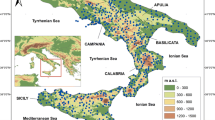Summary
This study is based on the 10-years homogeneous precipitation datas of 19 stations during 1960–1969.
The geographical distribution of annual precipitation shows a general decrease from west to east and from north to south, with a zone of more than 1600 mm centrad at Bandar Pahlavi.
The rainfall regime of Caspian costal plains, comprises a principal maximum in autumn, a second maximum in March and a minimum in May or July. The regime of southern central Elburz is semi Mediterranean type. The mean annual precipitation increases with altitude in southern slopes of Elburz and decreases with altitude in the northern parts of the region.
The precipitation variability was studied by the coefficient of variation. In the coastal plains of the Caspian Sea, the coefficient of variation has a constant value of about 18 and is independent of mean annual precipitation. In the southern region of Elburz, this coefficient is much larger (varies from 27 to 83) and decreases with the increasing mean of annual precipitaiton. The correlation coefficients between monthly rainfall of any two stations of each sides of Elburz are generally high and significant, but they are not significant between one station from northern and the other from southern slope. This demonstrates that the precipitation in both sides of central Elburz are from different origins.
The mechanism of the intense rainfalls in south west of the Caspian Sea (Bandar Pahlavi) probably consists of a advection of Siberian cold air mass through the Caspian Sea, because of which the stability of air decreases and its specific humidity increases. Caspian maritime air mass, from one side, and the Continental air of central Iran, from the other side, contact at the Mouth of the Sefid Rood valley (Bandar Pahlavi region) and cause the intensive rains.
Zusammenfassung
Der Untersuchung liegen 10jährige homogene Niederschlagsreihen von 19 Stationen aus 1960–1969 zugrunde.
Die Jahresmengen des Niederschlages nehmen im allgemeinen vom Westen gegen Osten und von Norden gegen Süden ab und erreichen ein Maximum über 1600 mm im Gebiet von Bandar Pahlavi.
Der Jahresgang der Niederschlagsmengen weist in den Küstenebenen am Kaspischen Meer ein Hauptmaximum in Herbst, ein sekundäres Maximum im März und ein Minimum im Mai oder Juli auf, im südlichen zentralen Elburz zeigt er seinen semimediterranen Typ. Die Jahresniederschlagsmengen nehmen auf den südlichen Hängen des Elburz mit der Höhe zu, in den nördlichen Teilen des Gebietes aber mit der Höhe ab.
Die Veränderlichkeit des Niederschlages wird durch den Variationskoeffizienten charakterisiert. Dieser ist in den Ebenen am Kaspischen Meer mit ungefähr 18 überall nahezu gleich und unabhängig von der Jahresniederschlagsmenge. Im südlichen Teil des Elburz ist er bedeutend größer (27 bis 83) und nimmt mit zunehmender Niederschlagsmenge ab. Die Korrelationskoeffizienten zwischen den Monatsniederschlagsmengen zweier Stationen auf derselben Seite des Elburz sind im allgemeinen groß und signifikant, sie sind aber zwischen einer Station im Norden und einer am Südhang des Elburz nicht signifikant. Dies zeigt, daß die Niederschläge auf beiden Seiten des Elburz von verschiedenem Ursprung sind.
Die intensiven Regenfälle südwestlich vom Kaspischen Meer bei Bandar Pahlavi sind wahrscheinlich auf eine Advektion sibirischer Kaltluft über das Kaspische Meer zurückzuführen, wobei die Stabilität der Luft abnimmt und die spezifische Feuchte zunimmt. Maritime Luft vom Kaspischen Meer und kontinentale Luft aus dem zentralen Iran treffen sich im Mündungsgebiet des Sefid-Rood-Tales (Gebiet von Bandar Pahlavi) und verursachen dort die intensiven Niederschläge.
Similar content being viewed by others
References
Adle, A. H.: Climats de l'Iran. Univ. of Teheran, No.584, pp. 98–100, 121–131 (1960).
Birot et Dresch: La Mediterranée et la Moyen Orient. Tome II, pp. 160–163. Presse Univ. Paris, 1956.
Brooks, C. E. P., and N. Carruthers: Handbook of Statistical Methods in Meteorology. Pp. 286, 303. London: Her Majesty's Stationery Office, 1953.
Djawadi, Ch.: Distribution climatiques en Iran. Monographie Méteorol. Nat. Paris, 1966.
Gandji, H.: Distribution climatique en Iran. Rev. de fac. des letters, Univ. de Téhéran, No. 1,3, 3–7 (1954).
Hashemi, F.: A Statistical Analysis of the Annual Monthly and Daily Precipitation of Teheran. Iranian Meteorol. Dept., pp. 5–6, Teheran, 1969.
Khalili, A.: Contribution à l'etude statistique et dynamique des précipitations atmosphériques au sud est de la Mer Noire. Pp. 143–146. Thesis presented to Fac. of Sci. Univ. of Paris, 1965.
Khalili, A.: On the Origine of Southern Caspian Sea Rainfall. Pub. of Iranian Met. Dept., March 1971.
Khalili, A.: Rainfall Regimes of Central Elburz. Irrigation and Drainage Seminar, Ministry of Water and Electricity, Teheran 1970.
Khalili, A.: Elburz, grande frontière climatique de l'Iran, Journal de Téhéran, No. 10519, 1970.
Khodayari, E.: Contribution à l'étude des précipitations atmosphériques au sud-ouest de la mer Caspienne. Thesis presented to Fac. of Sci. Univ. of Paris. Pp. 82–92 (1970).
Lomas, J.: Prévision du rendement des récoltes de blé en Iran à partir de données pluviométriques. Bulletin de l'OMM21, 6–11 (1972).
Author information
Authors and Affiliations
Additional information
With 7 Figures
Rights and permissions
About this article
Cite this article
Khalili, A. Precipitation patterns of central Elburz. Arch. Met. Geoph. Biokl. B. 21, 215–232 (1973). https://doi.org/10.1007/BF02243729
Received:
Issue Date:
DOI: https://doi.org/10.1007/BF02243729




